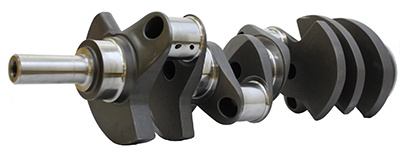Crankshafts
Should I Buy a Cast or Forged Crankshaft?
If you need a crankshaft for the engine in your bulldozer, excavator, wheel loader or other type of machine, you may have come across two different types - cast and forged. What is the difference you may be wondering? Is one better than the other?
CASTED CRANKS
In casting, a mold using cast iron poured to create a raw cast. Casting is cheap, strong, and the cast comes out very close to the required dimensions. Cast cranks are what you’ll generally find OEM and in almost all machines.
FORGED CRANKS
Forged cranks are made using a completely different process. In forging, a hot chunk of rolled steel is placed between heavy dies having the pattern of a crankshaft. Under extreme pressure supplied by a forging press, the metal is squeezed into the crank’s basic shape.
An improved forging process involves forging the crank in two planes, so that all the journals are pressed into their final configuration, eliminating the need to twist the crank to index the journals.
So, what is the difference between the two types of crankshafts? Forged cranks are usually the better option, although they’ll cost more money. A forged crankshaft has fewer internal stresses in the forging process, as well as an improved grain flow in the metal.
Both cast and forged cranks are used with various materials. Some are stronger than others. The least durable are standard cast-iron with tensile strength of 65 to 80,000-psi. Many iron cranks are made from nodular iron, improving the tensile strength to 100,000-psi with a ductility of about 5 percent elongation before failure.
Forged cranks also come in a wide range of materials with varying degrees of strength. A factory-forged crank is typically manufactured from plain carbon steel with a tensile strength in the 110,000-psi range. More importantly, a forged-steel crank has an elongation rating of 20-22 percent before failure making the ductility of a forged crank a major advantage over cast iron.
BILLET CRANKS
Billet crankshafts are at the top end of the high-performance crankshaft scale. A billet crank starts as a solid hunk of high-grade steel that is machined into a crankshaft.
The advantage of billet is primarily in the grain structure. The rolled bar that forms the billet has a uniform longitudinal grain structure. The material isn’t pounded and pressed, as a result, the grain structure isn’t affected making the final product stronger and more durable.
For a more detailed description of both cast and forged crankshafts, check out this article.
Need Engine Parts?
Call an Engine Specialist Today





